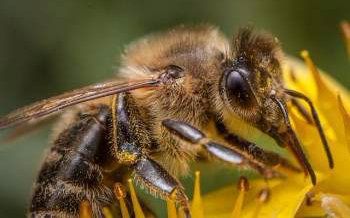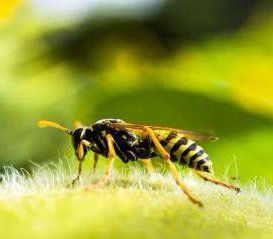When a Pomeranian is Stung by a Bee, Wasp or other Stinging Insect

Overview
There are many stinging insects that can attack dogs, this includes bees, hornets, wasps and yellow jackets.
These bugs start to swarm in the springtime with the warm weather and will continue to be present until the late fall when they either die off or hibernate.
Dogs are particularly vulnerable to bee and other insect stings because these insects may have nests close to the home in areas where humans often do not get close to, but dogs may point their noses.
In addition, ground bees are known to sting dogs since they hover very close to the grass. These include sweat bees, mining bees and digging bees.
Each typically build nests in soil and then male drones patrol the area, protecting the female that can sting.
Yellow jackets and wasps can also live in ground burrows. Since they are right at the level of a small toy breed like the Pom, they can sting a puppy or dog on the belly, legs, paws or face.
If you think that your Pom is safe near bumblebees or that he won't be stung a second time, it's important to note that this is not true.
You may be surprised to know that many insects including bees do not die necessarily die after stinging and that big fat bumblebees (the females) are capable of stinging; as these are two of the most widespread myths.
This section will discuss:
- The difference between bees, wasps, hornets and yellow jackets
- How to react if wasps or other stinging insects swarm your Pom
- What to do if your Pomeranian is stung by a bee or other stinging insect
- How to treat a bee sting
- Signs of an allergic reaction
- Reasons to take your Pom to the vet vs treating this at home
- Some prevention steps to decrease the odds of a bee attacking your puppy or dog.
Bees, Wasps, Hornets & Yellow Jackets
Dogs, and especially toy breeds like the Pomeranian that have short legs with bellies and faces close to the ground, are targets for stinging insects. Many of the offenders will hover in places that a Pom may innocently be walking over or near.
Since these insects can move very fast, it may not be clear if the attacker was a honeybee, other type of bee, wasp, hornet or yellow jacket.
Bees -
Only the honey bee dies after stinging; all other varieties can sting a dog (or you) numerous times. There are over 20,000 species of bees and 70% live underground or at ground level.
Wasps -
A wasp rarely strings once and will typically attack a dog or human several times.
The pain can last a long time since elements in the venom slow down blood flow that would otherwise dilute the venom.
Some types, such as the Ground Digger Wasp live near the ground in gardens and other such places.
Yellow jackets -
These are exceeding dangerous. They not only sting, they can bite as well and often do so completely unprovoked.
Swarms can be found at ground level since they often make their nests in abandoned rodent holes.
Hornets -
They can sting a dog repeatedly since the stingers are not pulled out of the body. They can have nests in shrubs and on the ground. Stings are more painful than wasps due to a high level of venom.
What to Do if Your Pomeranian is Being Attacked by Bees or Other Stinging Insects
Whether just a single wasp is attacking your dog or your Pom is being swarmed by bees, you should react in the same way since you may have no idea if your puppy or dog is allergic to the venom or how many times a single insect may inject his stinger.
The only real way to help your Pom escape being attacked by bees or other insects is to pick up your Pom and run. Do not try and swat the bug(s) or flail your arms in an attempt to make them go away, since this can be interpreted as an aggressive action that triggers a stronger attack.
Pick up your Pom securely so that he is not jostled and run as quickly as possible.
The main areas that a dog will be stung are those that are not covered with fur; this means that the Pomeranian's face, belly and paws are going to be attacked more than the main body.
If possible, tuck your Pomeranian under your shirt and then pull up the top of your shirt over your face while not obscuring your view. While a bee can still sting through clothing, it does offer somewhat of a barrier.
Your goal will be to seek a sheltered area such as a house, building or even your car, though do keep in mind that depending on the size of the swarm that was attacking your Pomeranian, some may follow you inside.
If bees or wasps enter into the house, you can flea to another room and close the door or in some cases, running into the bathroom and jumping into the shower with your Pom can make them fly away. If you can run into a well-lit building, these venomous pests can get temporary confused and be attracted to the windows.
What to Do After Your Pomeranian Has Been Stung
The most important element is to remove the stingers since many types will continue to release venom until they are removed. However, if they are pulled out by fingers or even tweezers, this can also release venom into your dog's bloodstream.
The best method is to grab a driver's license or credit card and use a scraping motion over the skin to pull them out.
Since Pomeranian have full and very thick coats of fur, you will need to carefully part the fur in 1/2 inch sections, looking for stingers. Be sure to check all areas of the body including the tail and under the chin.
You may wonder if you need to bring your Pomeranian to the vet if he has only been stung one time. The element to keep in mind with this is that:
- Any puppy or dog can have an allergic reaction to any stinging insect such as wasps, hornets, yellow jackets and bees
- Not having an allergic response in the past does not mean it cannot happen the next time; some dogs may have been okay with one previous sting but will react badly the second time or if stung more often than the first time.
- Even if a Pomeranian has proven to not be allergic to a bee, he may have a response to a wasp and vice-versa. This holds true for just about any bug, though most dogs that are allergic to wasps are also going to react badly to hornets.
- While signs of an allergic attack
can begin almost immediately, it can take up to 45 minutes for symptoms to appear… and if a Pom is indeed allergic, you will want him already at the vet as opposed to waiting and being too late to respond.
Therefore, unless you know for a fact which insect stung your Pomeranian, your dog has a clear history of not being allergic to that venom AND you are positive in knowing how many times your dog was stung, you should bring your Pom to the veterinarian.
At the vets, he can be checked for stingers that you may have missed, be treated for the pain if necessary, receive treatment for possible swelling and be given either precautionary allergy medication such as Dexamethasone or be given the reactionary treatment of epinephrine for anaphylactic shock.
At-Home Treatment for a Pomeranian That Was Stung by a Bee
If the above does not apply to your Pom and you feel safe in keeping him at home and being treated at home, there are some things that you can do to help with discomfort and swelling.
1)
Be sure that all stingers have been properly removed by scraping them out.
2)
Clean the injection site on your Pomeranian with warm water and soap to remove body oils that may impede further treatment.
3)
If a wasp or hornet has stung your Pom, a small piece of cloth soaked in vinegar should be applied to the bite for 15 minutes. This will help neutralize the alkaline in the venom.
If a bee and yellow jacket has attacked your Pom, a paste made of water and baking soda should be applied to the skin for 15 minutes.
For each of these, treatment may be repeated if the puppy
or dog is still showing signs of discomfort or if the area is very red.
4)
Once this is done, it can help to apply a small ice pack to help with the swelling.
5)
Anything other than a very minor case of an allergic reaction MUST be treated at the veterinarians where a powerful drug such as epinephrine may need to be used. With this said, for very minor cases, Benadryl may be given, but check with your vet first for proper dosing.
Typically, Benadryl is given based on the weight of the dog, regardless of age. The following doses are typically recommended and as you can see, in general it will be 1 milligram per pound of body weight, but you will still want to check with your veterinarian first, since age, health status, and other factors can affect dosing:
1 lb. (.45 kg) = 1 mg
2 lbs. (.90 kg) = 2 mg
3 lbs. (1.36 kg) = 3 mg
4 lbs. (1.81 kg) = 4 mg
5 lbs. (2.26 kg)= 5 mg
6 lbs. (2.72 kg) = 6 mg
7 lbs. (3.17 kg) = 7 mg
8 lbs. (3.62 kg) = 8 mg
9 lbs. (4.08 kg) = 9 mg
10 lbs. (4.5 kg) = 10 mg
6)
Keep a very close eye on your Pomeranian to look for any signs of an allergic reaction. This can come on quickly and it can take up to 45 minutes to develop.
Signs and Symptoms of Being Allergic
While rare, a dog can suffer from Anaphylaxis, which is a life-threatening allergic reaction. Without treatment, it can lead to shock, cardiac arrest and death.
The most common signs include:
- Swelling of the face - Even if the dog was not stung on the face, areas of the face may swell. This includes one or both eyes, around the lips or any other area.
- Severe swelling at the sting site - If red, irritated skin does not fade down and/or if the bump does not recede.
- Weakness - This includes any out of the ordinary behavior including acting overly tired, confused or having marked lethargy.
- Trouble breathing - This includes raspy breathing, making gagging noises, heavy or shallow breathing.
Other possible signs include:
- Rash - This is not always present, however this includes red bumps or hives
- Vomiting - While this is not always a symptom, a dog that is having an allergic response to insect stings may dry heave or throw up.
- Pale gums - Gums may appear white, light blue, light gray or very pale pink.
- Cold limbs - A dog's legs may be colder to the touch than other parts of the body.
- Drooling - There may be excessive salivation
Emergency Treatment for Bee Stings - Just like humans, a dog that is having an Anaphylaxis response needs immediate treatment with Epinephrine. When given quickly enough, it will stop the things in their tracks. In some cases, this will need to be administered literally within minutes, and for this reason keep a close eye on your Pom or bring him to the vet after being stung.
Preventing Your Pom From Getting Attacked by Bees
1) Do not allow your Pomeranian to be outside unsupervised. Even if you have a nice and safe fenced in yard and you only want to let your Pom out to quickly pee, there are so many things that can go wrong.
A small dog can be bitten by a snake, attacked by bees or even scooped up by a hawk. He can nibble on poisonous plants, eat feces or stick his nose in a hill of red ants.
The dangers are endless and this
toy breed dog should never be outside by himself.
2)
When you are outside with your Pom, whether in your yard or out for a walk, do not allow him to stick his nose into areas where bees, wasps or other stinging insects may have built a nest.
Remember that many of these insects do not live high in trees; they build nests either close to the ground (in bushes, shrubs, flower beds, etc.) or under the ground with the entrance right where a dog's may stick his nose while investigating.
3)
If you know that your Pomeranian is allergic to bees or other allergens that can cause anaphylactic shock, ask your veterinarian for a canine epi-pen that you can keep with you to immediately treat your puppy or dog.
The vet will instruct you on how to use this and these are very small, portable and easy to bring along no matter where you go with your Pom.
Are you part of the PetPom family?
Become a Free PetPom Member so that you'll receive a friendly reminder when we add new pages and sections to this site. You will also receive a fun & helpful Welcome Booklet.



